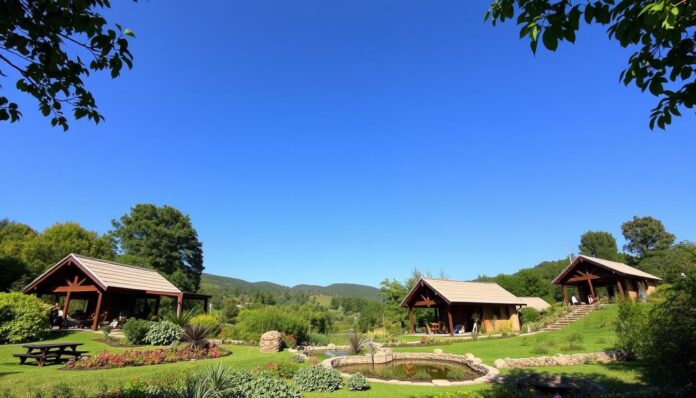Creating a thriving permaculture retreat center is a big task. It involves offering eco-friendly accommodations and promoting sustainable living. As more people seek environmentally conscious retreats, permaculture is becoming a key approach. It helps centers reduce their environmental impact while offering guests a unique experience.
A permaculture retreat center can be a model for living sustainably. It showcases the latest eco-friendly technologies and practices.
Key Takeaways
- Permaculture retreat centers offer a unique approach to sustainable living and eco-friendly accommodations
- Designing a permaculture retreat center requires careful consideration of environmental factors and guest needs
- Incorporating permaculture principles can help minimize a retreat center’s environmental footprint
- Successful permaculture retreat centers, such as Jiwa Damai and Hawaiian Sanctuary Retreat Center, serve as models for sustainable living
- Creating a permaculture retreat center requires a holistic approach to design, management, and community engagement
- Permaculture retreat centers can provide a transformative experience for guests, promoting environmental awareness and personal growth
- By following permaculture principles, retreat centers can create a thriving and sustainable community that benefits both people and the planet
Introduction to Permaculture Retreat Centers
Permaculture retreat centers offer a special chance to dive into nature and learn about living green. They blend nature immersion with green living and hands-on learning. A big part of permaculture is organic gardening, growing plants without harmful chemicals.
Places like Suryalila Retreat Centre and Danyadara are leaders in permaculture. Suryalila is known as the World’s Favourite Yoga Retreat. Danyadara has planted over 5,000 trees to fight desertification. These centers show off permaculture’s wide range, from water systems to farming methods.
Want to learn more about permaculture? Check out workshops or courses like “Introduction to Permaculture & Yoga”. They cover permaculture basics, ecology, and more. By exploring permaculture retreat centers, you can understand sustainable living better and apply it in your life.
| Retreat Center | Location | Permaculture Features |
|---|---|---|
| Suryalila Retreat Centre | Spain | Water retention systems, regenerative farming |
| Danyadara | Southern Spain | Gray water systems, organic gardening |
Identifying the Ideal Location
When setting up a permaculture retreat center, think about climate, how easy it is to get to, and what’s already there. A place with lots of rain, like Jiwa Damai, is great for regenerative agriculture. The weather and climate of an area really matter for a permaculture retreat’s success.
A holistic retreat center should focus on environmental education. It should teach guests about living sustainably and connecting with nature. It’s also important to think about how easy it is to get there and what’s available. These things can make or break the guest experience and the retreat’s success.
- Climate and weather patterns
- Accessibility and infrastructure
- Availability of natural resources, such as water and fertile soil
By carefully thinking about these points, you can make a permaculture retreat center that’s both thriving and enriching. It will offer a special experience for guests while promoting regenerative agriculture and environmental education.
Designing Your Permaculture Retreat
When designing a permaculture retreat center, it’s key to use natural elements. This helps promote sustainable living. For instance, the Hawaiian Sanctuary Retreat Center shows how to do this well. It has designed its facilities to be as green as possible.
A good permaculture retreat should focus on sustainable living. This means using renewable energy, organic gardens, and reducing waste. These steps help lower the center’s carbon footprint and make the environment healthier for everyone. Important design ideas include:
- Using locally sourced materials for construction
- Implementing rainwater harvesting and greywater recycling systems
- Creating diverse ecosystems through permaculture gardening and landscaping
By choosing eco-friendly accommodations and green living principles, permaculture retreats offer a special experience. They also help create a more sustainable future.
Understanding Permaculture Principles
Permaculture is all about creating a sustainable ecosystem. A permaculture retreat center is a great example. It uses organic gardening and regenerative agriculture to reduce its impact on the environment.
The core of permaculture is three ethics: Earth care, people care, and fair share. These guide how permaculture systems are designed and managed. They make sure these systems are good for the planet, fair for people, and work well economically. This way, a permaculture retreat center can offer a unique and educational experience to its guests.
Important permaculture principles include diversity, stacking functions, and planned redundancy. These help create a diverse and strong ecosystem. Each part of the system does more than one thing, helping the whole system stay healthy and productive. By following these principles, a permaculture retreat center can be a model for living sustainably and a place for learning and community.
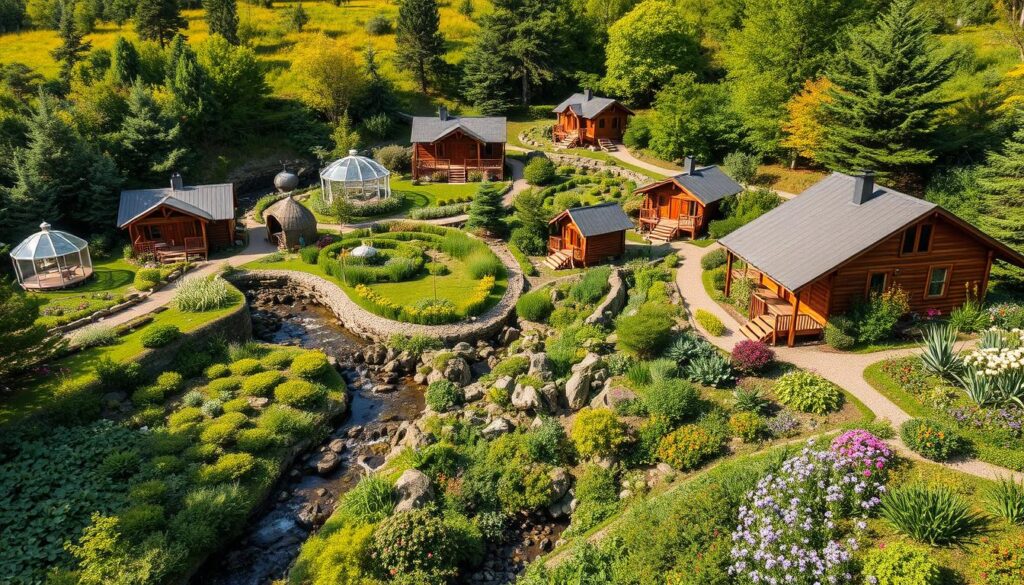
| Permaculture Principle | Description |
|---|---|
| Earth Care | Protecting and preserving the natural environment |
| People Care | Supporting and empowering individuals and communities |
| Fair Share | Sharing resources and benefits in a fair and equitable manner |
By using these permaculture principles, a retreat center can become a thriving, sustainable place. Guests can learn and see the good of regenerative agriculture and organic gardening firsthand.
Building Infrastructure
Setting up a permaculture retreat center means building infrastructure first. This step is key. It involves making eco-friendly accommodations for guests to enjoy nature fully. A holistic retreat aims to connect guests with nature and support sustainability.
Choosing the right materials and energy is vital. Jiwa Damai, for instance, uses materials that are good for the planet and energy that’s renewable. This choice cuts down on harm to the environment. It also makes guests’ experiences unique and memorable.
- Using local and renewable materials for construction
- Implementing energy-efficient systems and renewable energy sources
- Designing accommodations that promote nature immersion and a sense of connection to the environment
By focusing on sustainability and eco-friendliness, permaculture retreats offer a special holistic retreat experience. This benefits both guests and the planet.
Creating Diverse Ecosystems
Setting up a permaculture retreat center means making diverse ecosystems. These ecosystems boost biodiversity and regenerative agriculture. They also offer a chance for environmental education. By using organic gardening methods, these centers show how to live sustainably.
Choosing many plant types is key to diverse ecosystems. This includes native plants, flowers for pollinators, and trees for shade and animal homes. This way, permaculture retreat centers can build environments that are full of life.
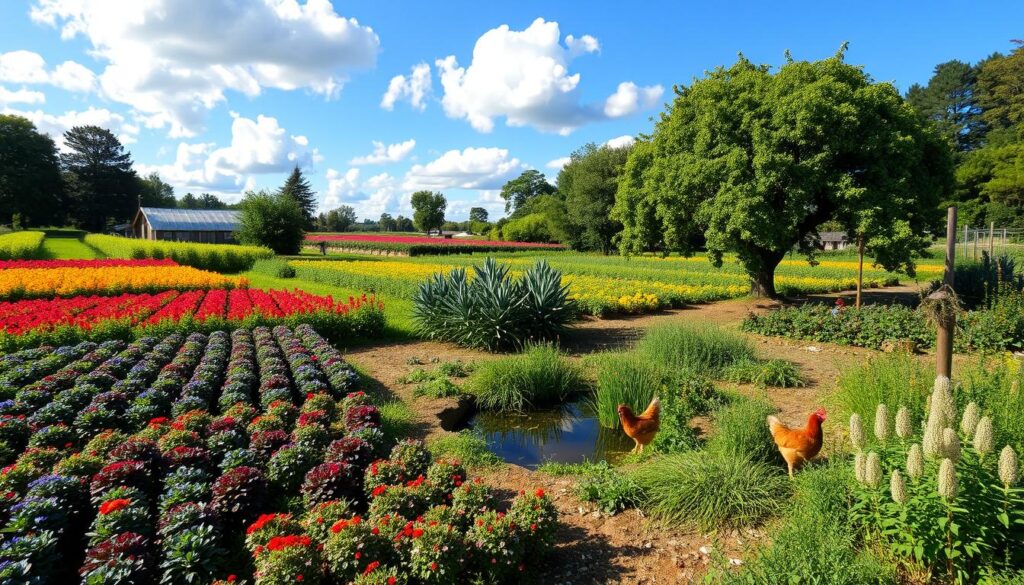
Places like the Hawaiian Sanctuary Retreat Center have done this well. They have many plants and animals. This shows how permaculture can help nature and local ecosystems. Other centers can follow these steps to make their own ecosystems and help the planet.
Water Management Strategies
Effective water management is key for permaculture retreat centers. It makes the place more sustainable and eco-friendly. Using rainwater harvesting, greywater recycling, and smart irrigation can cut down water use. This fits well with living sustainably and green.
Eco-friendly places like Jiwa Damai show how it’s done. They use rainwater and greywater to save water.
Some important water management steps are:
- Rainwater harvesting: Collecting rainwater for uses other than drinking. This lowers the need for groundwater and city water.
- Greywater recycling: Using greywater from sinks and showers for plants. This cuts down freshwater use for gardens.
- Efficient irrigation techniques: Using drip irrigation or mulching. This helps save water by reducing evaporation and runoff.
By using these strategies, permaculture retreat centers can lessen their environmental effect. They also set a good example for living sustainably and green. This encourages guests to adopt eco-friendly ways in their daily lives.
Developing Educational Programs
Environmental education is key in a holistic retreat. It gives guests a special learning chance. A good curriculum helps them understand regenerative agriculture better. For example, the Hawaiian Sanctuary Retreat Center has workshops and hands-on activities. These focus on sustainable living and caring for nature.
When making educational programs, think about what guests want to learn. Topics can range from permaculture to saving the environment. Experiential learning helps guests learn by doing. This way, they get skills and knowledge to use at home. Some programs include:
- Permaculture design certificate programs
- Ecological conservation workshops
- Sustainable living courses
Working with experts makes learning even better. This brings guests a lot of knowledge and experience. By teaming up with those who know a lot about regenerative agriculture, retreats offer a deep learning experience. This experience helps guests grow personally and helps the planet.
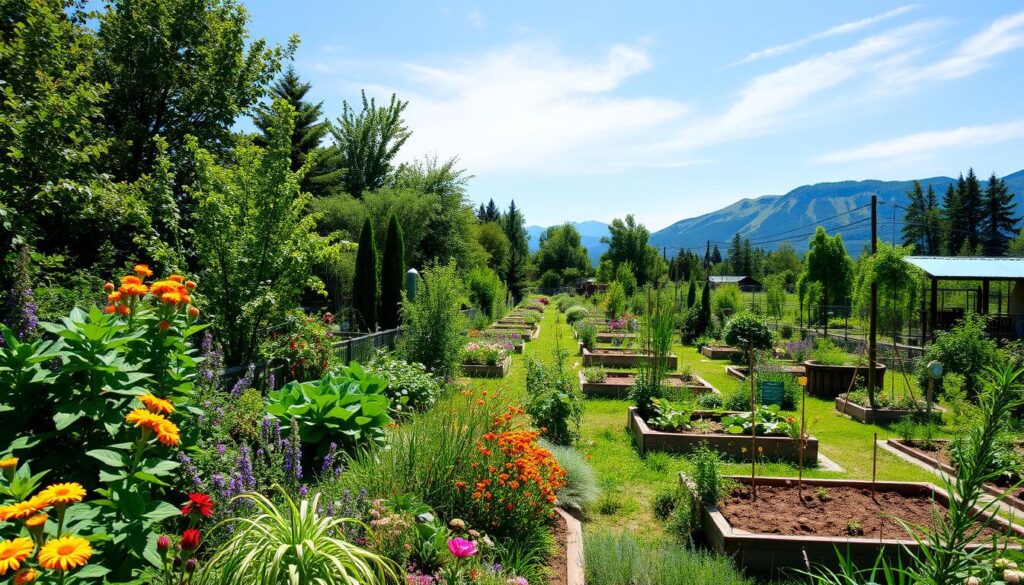
Marketing Your Retreat Center
Marketing well is key for a permaculture retreat center’s success. You need to know who to attract and plan a marketing strategy that fits. Show off what makes your center special, like green accommodations and living sustainably.
A good website and social media are great for showing off what you offer. Jiwa Damai, for example, uses social media to share its retreat center and talk to its followers. This way, more people can see and be interested in your center.
Some important things to think about when marketing your retreat center include:
- Having a strong online presence with a website and social media
- Finding and reaching the right people for your retreat center
- Creating interesting content that highlights what makes your center special
With a smart marketing plan, your permaculture retreat center can show off its green living and eco-friendly stays. This will draw in guests who value the same things and are looking for a special retreat experience.
| Marketing Channel | Benefits |
|---|---|
| Social Media | Increased visibility, engagement with audience |
| Website | Central hub for information, showcases center’s offerings |
| Email Marketing | Targeted communication with potential guests, promotes events and activities |
Funding and Financial Planning
Starting a permaculture retreat center needs a lot of thought about money. You must plan your budget, look for grants, and set prices that support sustainable living and eco-friendly accommodations. It’s also important to know if people want these kinds of retreats. The interest in green living has grown a lot lately.
The need for eco-friendly accommodations has made more retreat centers pop up. For example, the Hawaiian Sanctuary Retreat Center has prices that encourage green living and growing food in a good way. By doing the same, permaculture retreat centers can draw in guests who care about the planet. This helps grow sustainable living even more.
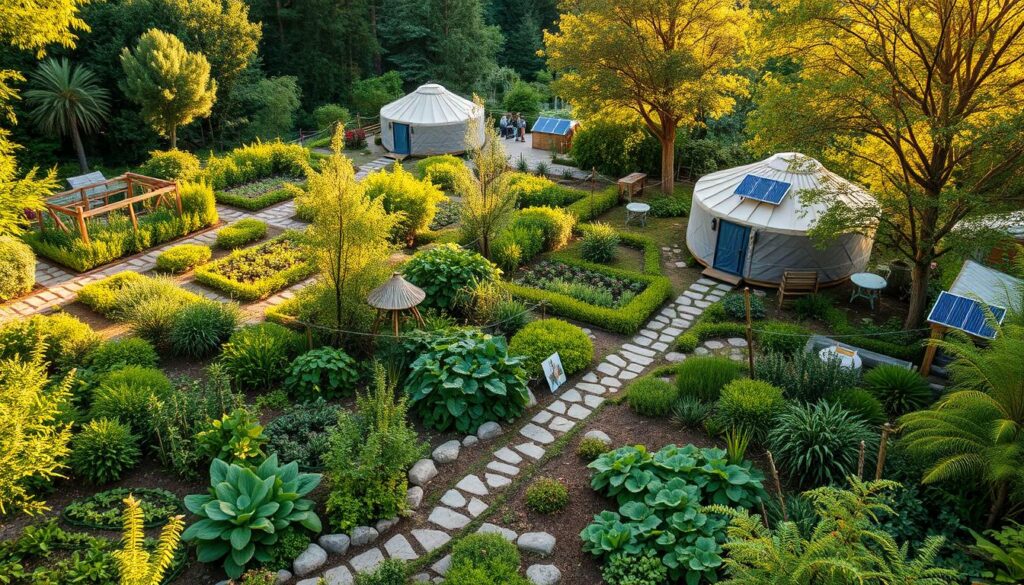
To stay financially strong, retreat centers can look for different ways to get money. This includes grants and working with groups that support eco-friendly projects. By finding many ways to make money and setting prices that are fair, permaculture retreat centers can keep going strong. They also help spread the word about green living.
| Retreat Center | Pricing Strategy | Sustainable Features |
|---|---|---|
| Hawaiian Sanctuary | Sliding scale fees | Regenerative agriculture, eco-friendly accommodations |
| Bambu Guest House | Package deals | Organic food, community service projects |
Legal Considerations
Starting a permaculture retreat center means looking at legal stuff. This includes getting permits, following zoning rules, and getting insurance. A holistic retreat must follow all laws to keep guests safe and happy. Jiwa Damai is a great example of a place that does this right.
Some important things to think about for a permaculture retreat center are:
- Getting the right permits and licenses
- Following zoning rules
- Getting enough insurance
- Creating and following health and safety rules
By dealing with these legal points, a permaculture retreat center can be a success. It can teach guests about environmental education and well-being. This might include using rainwater and composting, and offering workshops.
In the end, a well-run and legal permaculture retreat center can offer a special and enriching experience. It also helps with sustainability and taking care of the environment.
| Aspect | Considerations |
|---|---|
| Permits and Licenses | Get the needed permits and licenses to run a permaculture retreat center |
| Zoning Regulations | Follow local zoning rules and laws |
| Insurance Coverage | Get enough insurance to cover risks and liability |
Community Engagement and Support
Community engagement and support are key for a permaculture retreat center. They help build a thriving and sustainable ecosystem. By working closely with the local community, centers can promote sustainable living and offer eco-friendly accommodations.
The Hawaiian Sanctuary Retreat Center is a great example. It has volunteer programs and hosts community events. This shows how important community support is for a successful permaculture retreat.
Building Relationships Locally
- Collaborate with local organizations and businesses to promote sustainable practices
- Host workshops and events that educate the community on permaculture principles and green living
- Develop volunteer programs that support the local community and promote sustainable living
By focusing on community engagement, permaculture retreat centers can make a big difference. They positively impact the environment and the local community. Guests also get a unique and enriching experience.
Maintaining Biodiversity and Sustainability
Keeping biodiversity and sustainability is key for a permaculture retreat center. This is done through regenerative agriculture practices. These practices build healthy soil, save water, and support ecosystems. A holistic approach to sustainability is vital. It includes teaching about the environment and engaging with the community.
Places like Lost Valley Educational Center show how to keep ecosystems healthy. They offer many educational programs. These include permaculture design courses and holistic sustainability semesters. These programs teach about living sustainably and caring for the environment.
Important steps for keeping biodiversity and sustainability include:
- Using regenerative agriculture, like no-till farming and composting
- Conserving water with rainwater harvesting and smart irrigation
- Supporting ecosystem services, like pollination and pest control, by saving biodiversity
By using these methods, permaculture retreat centers can create a sustainable and thriving place. They offer a unique and educational experience for visitors. This approach helps the environment and supports the local community, making the retreat experience holistic.
Establishing a Sense of Place
Creating a sense of place is key for a permaculture retreat center. It lets guests connect with nature and the community. A center that focuses on sustainable living and eco-friendly accommodations offers a unique and transformative experience.
The Hawaiian Sanctuary Retreat Center is a great example. It offers personalized retreats and unique experiences. Guests can connect with nature and themselves. This helps them appreciate the natural world and adopt sustainable living practices.
Some important steps to establish a sense of place include:
- Creating unique experiences, such as workshops and community gatherings
- Enhancing guest comfort and amenities, such as eco-friendly accommodations and organic meals
- Personalizing the retreat experience, such as offering one-on-one coaching and mentoring
By focusing on these elements, permaculture retreat centers can create a unique and transformative experience. This promotes sustainable living and eco-friendly practices.
| Retreat Center | Unique Experiences | Eco-friendly Accommodations |
|---|---|---|
| Hawaiian Sanctuary Retreat Center | Personalized retreats, workshops, and community gatherings | Organic meals, eco-friendly accommodations, and sustainable living practices |
Success Stories and Case Studies
Starting a permaculture retreat center can be very rewarding. Learning from others is a great way to begin. Jiwa Damai and Hawaiian Sanctuary Retreat Center are two examples of success. They focus on sustainable and regenerative practices, offering a holistic retreat experience.
These centers are all about environmental education and community. They use permaculture principles to create a thriving ecosystem. For instance, Jiwa Damai uses a rainwater harvesting system to cut down on water use.
Some key benefits of these centers include:
* Less water use thanks to rainwater harvesting and greywater recycling
* More biodiversity with wildlife habitats and support for local ecosystems
* Healthier soil from natural fertilizers and composting
* Stronger community through educational programs and workshops
By studying these success stories, you can start your own permaculture retreat center. It will help promote environmental education and sustainability in your community.
| Retreat Center | Location | Notable Features |
|---|---|---|
| Jiwa Damai | Bali, Indonesia | Rainwater harvesting, greywater recycling, and permaculture gardens |
| Hawaiian Sanctuary Retreat Center | Hawaii, USA | Organic farming, renewable energy, and environmental education programs |
Conclusion: Taking the Next Steps
Starting a sustainable permaculture retreat center is a big step, but it’s full of rewards. By focusing on green living and eco-friendly places, you can make a special spot that teaches and inspires. This place will be a thriving oasis for all who come.
Whether you’re beginning or updating a property, permaculture design is key. Look at the success stories in this article for ideas. Also, connect with others who share your vision for support and advice.
Your retreat center’s real value is in helping people connect with nature and live sustainably. By creating diverse ecosystems and using water wisely, you’ll make a big difference. Your center will be a place of transformation and lasting impact for everyone who visits.

